-

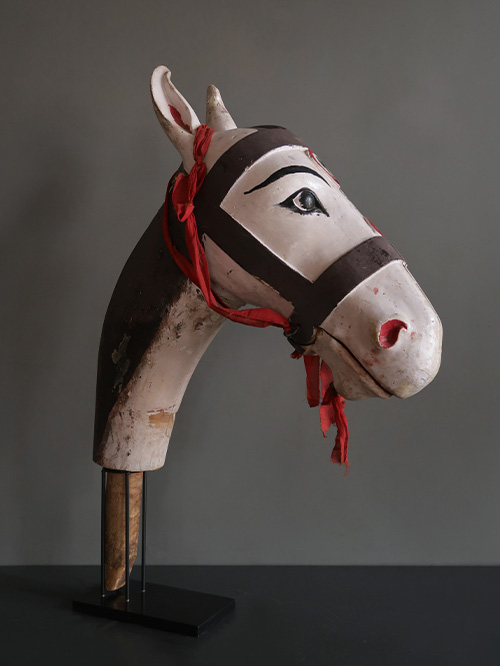
Konkan Region (Western India)
wood, polychromed
A painted wooden horse dancing mask with an articulated jaw. The head is worn through use but still shows its typical trappings.
This is a tribal dancing masks from the Konkan region used in the Perni Zagor, a folk play danced by Christian Gaud tribals. Perni Zagor is an indigenous dance-drama form of the Perni community of Goa. This is an ancient art form and is believed to have evolved on the banks of the Zuari river. It has its origins in fertility rites related to Neolithic shamanism. The dancers don wooden masks while performing the musical drama. The masks represent deities, animals, birds and demons. The characters are derived from various episodes in Hindu mythology. Perni Zagor is currently performed by only a few families in the community and is almost on the verge of extinction.
Size (cms): 86.5(H) x 57(W) x 17(D)
Size (inches): 34(H) x 22.5(W) x 6.5(D)
-
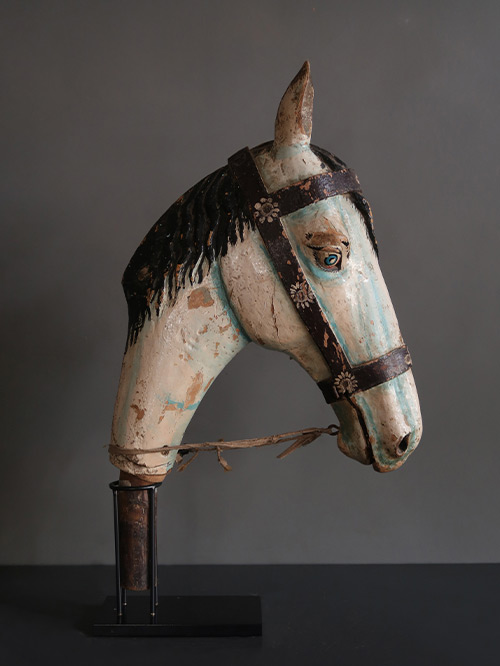
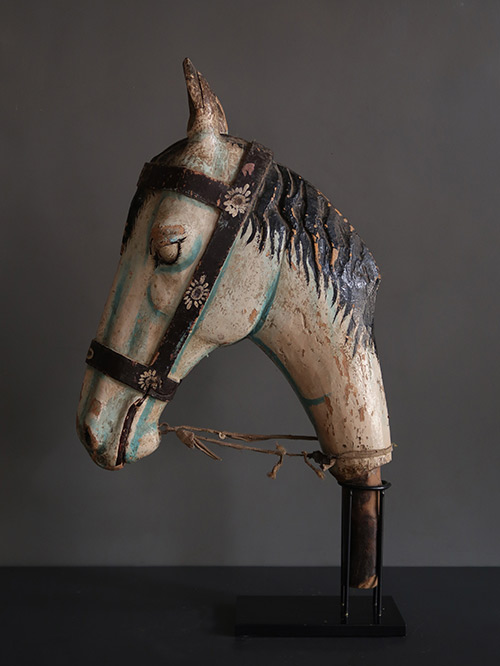
Konkan Region (Western India)
wood, polychromed
A painted wooden horse dancing mask with an articulated jaw. The head is worn through use but still shows its typical trappings.
This is a tribal dancing masks from the Konkan region used in the Perni Zagor, a folk play danced by Christian Gaud tribals. Perni Zagor is an indigenous dance-drama form of the Perni community of Goa. This is an ancient art form and is believed to have evolved on the banks of the Zuari river. It has its origins in fertility rites related to Neolithic shamanism. The dancers don wooden masks while performing the musical drama. The masks represent deities, animals, birds and demons. The characters are derived from various episodes in Hindu mythology. Perni Zagor is currently performed by only a few families in the community and is almost on the verge of extinction.
Size (cms): 77(H) x 44(W) x 17(D)
Size (inches): 30.5(H) x 17.5(W) x 6.5(D)
-
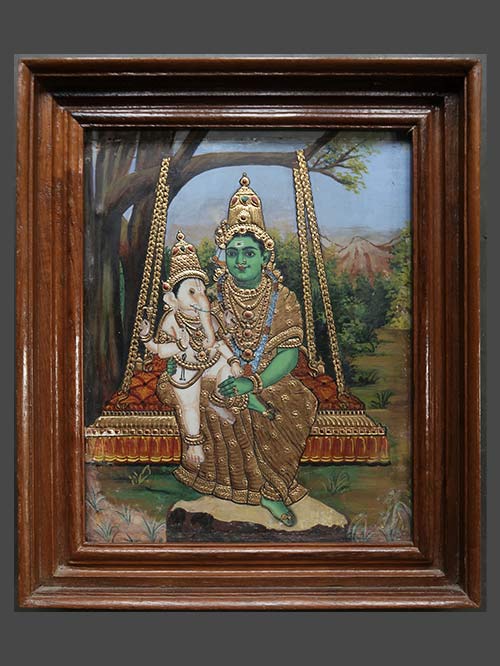
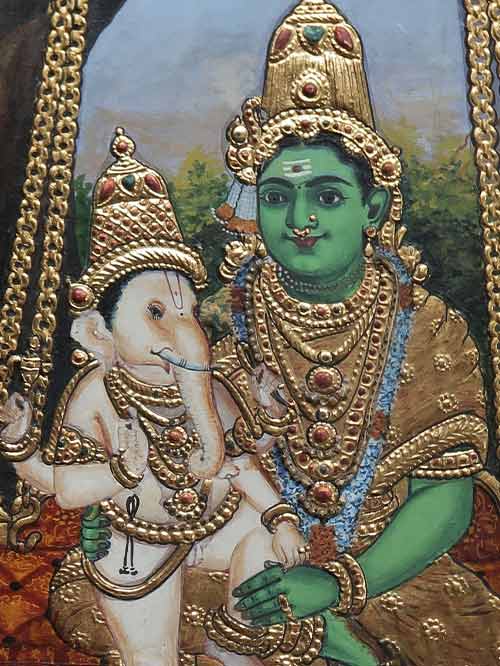
Tanjore (Tamil Nadu)
Opaque pigments and gold on panel
Parvati, crowned and dressed is an ostentatious golden sari, is seated on a plush swing balanced on a tree within a forest. On her lap sits her son Ganesha depicted as a child. Ganesha, naked but for his sumptuous jewellery carries an Ankusa (goad) and a Pasha (noose) in his hands.
Traditional Tanjore paintings were done on wooden panels which were typically seasoned teak wood or jack wood whose narrow strips were joined together. In some exceptional paintings precious stones were used as insets, but usually it was paste and strips of pure gold foil in which exquisite patterns were etched. Colours were prepared from natural extracts. There was a complete absence of light and shade effects except sometimes on the faces of the main figures. Strong bright and flat colours such as red, white, yellow, green and blue were used. Figures were often rotund, suggesting prosperity. Background colours were typically red, blue or green. The themes were predominantly religious but also included portraits of rulers and courtesans. Figures were usually placed within a pavilion with arches, curtains, pillars etc.
Painting Size (cms): 34 (H) x 28.5 (W)
Painting Size (inches): 13.4 (H) x 11.2 (W)
Framed Size (cms): 45.5(H) x 38.5(W)
Framed Size (inches): 18(H) x 15(W)
-

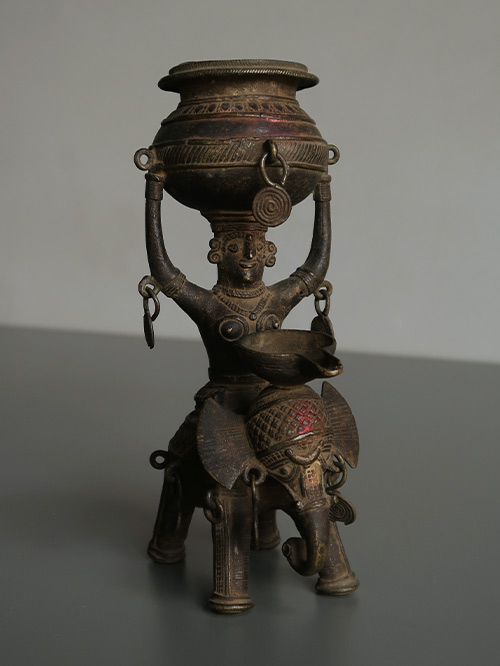
Bastar (Chhattisgarh, Central India)
Brass, Dokra work
An oil lamp depicting Panchdipa, the Goddess of Light who is depicted riding an elephant and bearing a kalasha, or pitcher for oil, on her head. The Goddess and elephant also provide support to a singular oil burner. The fine cross-hatching and details are typical of Bastar casting.
Dhokra is non–ferrous metal casting using the lost-wax casting technique. This sort of metal casting has been used in India for over 4,000 years and is still used. One of the earliest known lost wax artefacts is the dancing girl of Mohenjo-Daro. The product of dhokra artisans is in great demand in domestic and foreign markets because of primitive simplicity, enchanting folk motifs and forceful form. Dhokra horses, elephants, peacocks, owls, religious images, measuring bowls, and lamp caskets, etc., are highly appreciated.
Size (cms): 20(H) x 12.5(W) x 8.3(D)
Size (inches): 8(H) x 5(W) x 3.5(D)
-
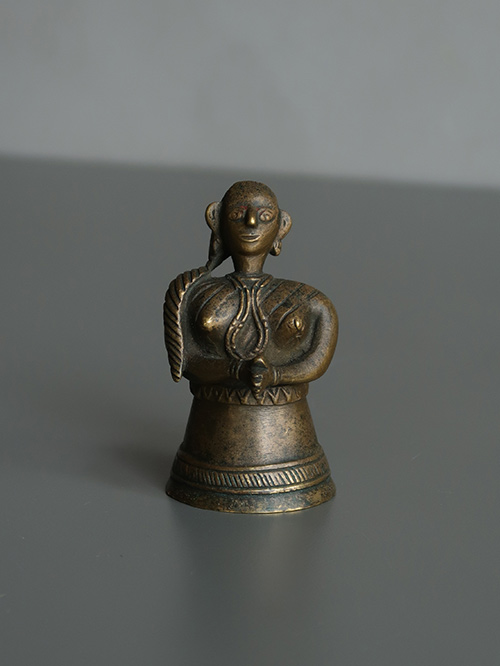
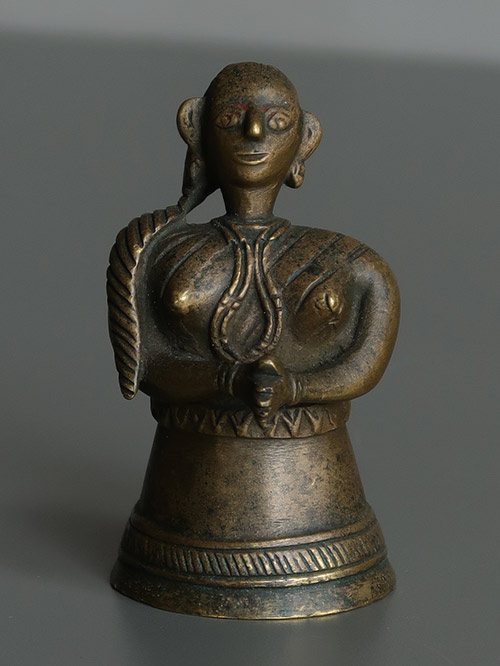
Bihar (East India)
Brass Alloy
An unusual bell cast in the form a girl with her hands held in anjali mudra with her long braided hair resting across her shoulder. Such figures were made using the cire-perdue technique (lost-wax) using dhuna, a black wax-like substance.
Bells play in an important role in anu puja (worship), especially when offering aarati ( waving a camphor or oil lamp before the deity to ward off evil); the worshipper rings the bell with the right hand, holding the lamp in the left hand.
Size (cms): 8.5(H) x 4.6(W) x 5.6(D)
Size (inches): 3.5(H) x 2(W) x 2(D)
-
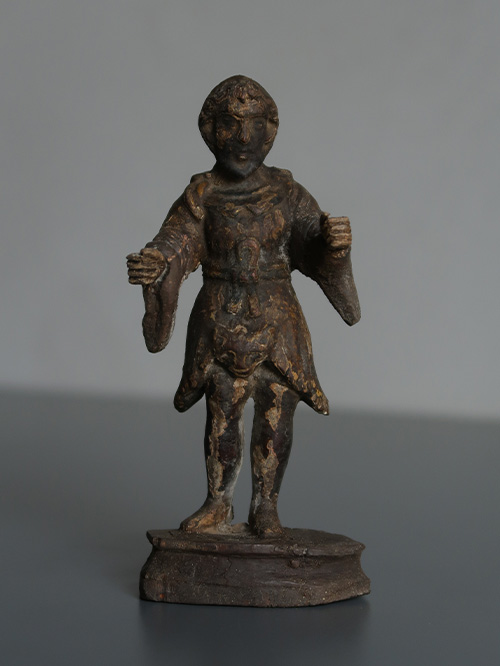
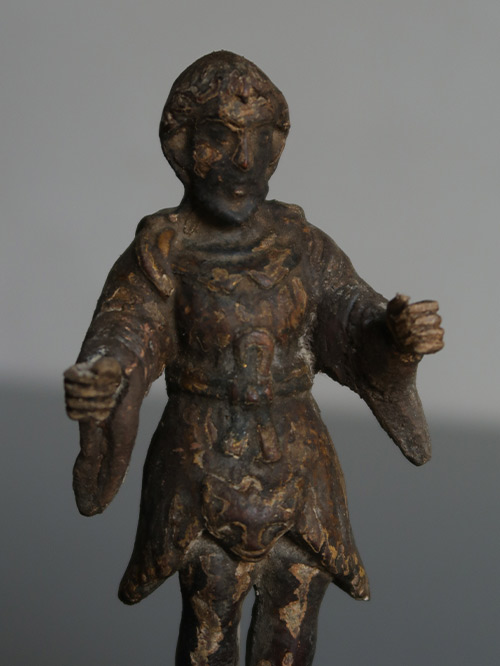
Goa (Indo-Portuguese)
Polychromed wood
A decorative in the round wood sculpture of Saint John the Baptist standing on a shallow base. John, a shepherd and ascetic, roaming the desert converting Jews in Roman times, is depicted as an ascetic. His face, “wild” hair and long beard, convey a strong determination and sense of purpose, as befits this roaming ascetic, precursor of Jesus, the Saviour. John is the Baptist in the Christian faith as he baptised Christ in the banks of the river Jordan.
Small religious sculptures such as the present one were instrumental in the didactic role of the church. As many local converts were illiterate, religious iconography was important in conveying doctrine and meaning. The present Saint Peter was most likely sculpted by an indigenous artist working under commission from the church authorities or from a local patron motivated by devout feelings.
Size (cms): 14(H) x 6(W) x 3.5(D)
Size (inches): 5.5(H) x 2.5(W) x 1.5(D)
-
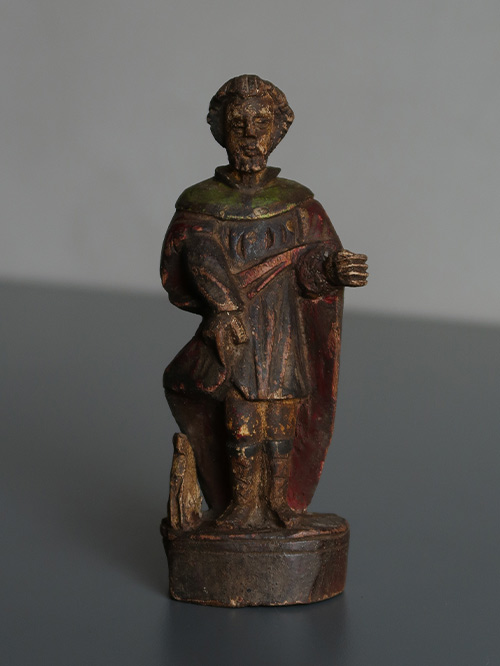
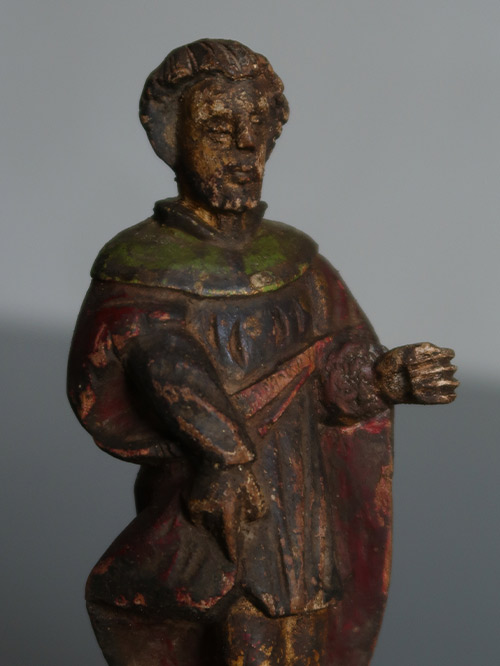
Goa (Indo-Portuguese)
Polychromed wood
A decorative in the round wood sculpture of Saint Joseph standing on a raised base. Dressed in a tunic and a mantle with accentuated and dynamic pleating, his face is inexpressive and distant, which bestows a certain majesty to the figure. His left hand would have held a stick, which is lacking. Saint Joseph was a Jewish man who according to the canonical Gospels married to Mary, the mother of Jesus. In Catholic traditions, Joseph is regarded as the patron saint of workers and is associated with various feast days.
Small religious sculptures such as the present one were instrumental in the didactic role of the church. As many local converts were illiterate, religious iconography was important in conveying doctrine and meaning. The present Saint Peter was most likely sculpted by an indigenous artist working under commission from the church authorities or from a local patron motivated by devout feelings.
Size (cms): 14.3(H) x 5(W) x 3.5(D)
Size (inches): 5.5(H) x 2(W) x 1.5(D)
-
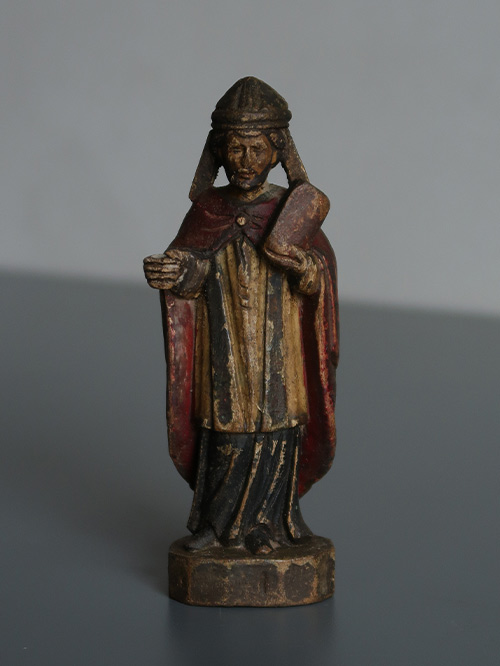
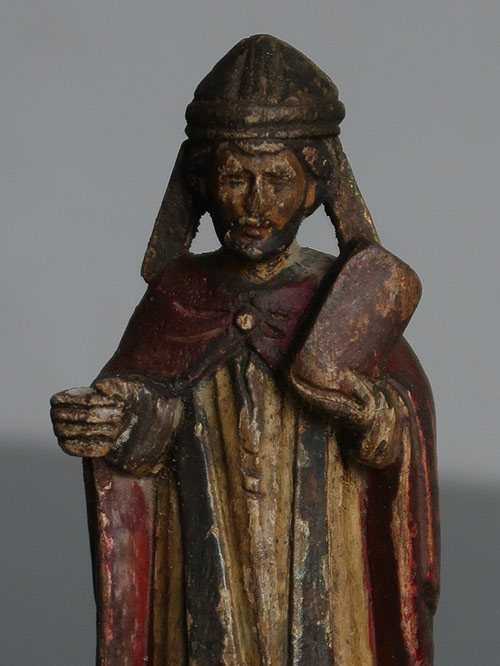
Goa (Indo-Portuguese)
Polychromed wood
A decorative in the round wood sculpture of Saint Peter standing on an ovular base. Dressed in a long gold tunic with a black sash and a red cape covering the shoulders and part of the arms. His face is inexpressive and stoic, which bestows a certain majesty to the figure. His right hand would have held a stick, which is lacking. Saint Peter, also known as Peter the Apostle, was one of the Twelve Apostles of Jesus Christ, and traditionally counted as the first Pope or bishop of Rome.
Small religious sculptures such as the present one were instrumental in the didactic role of the church. As many local converts were illiterate, religious iconography was important in conveying doctrine and meaning. The present Saint Peter was most likely sculpted by an indigenous artist working under commission from the church authorities or from a local patron motivated by devout feelings.
Size (cms): 13.4(H) x 4.5(W) x 3(D)
Size (inches): 5.5(H) x 2(W) x 1(D)

















